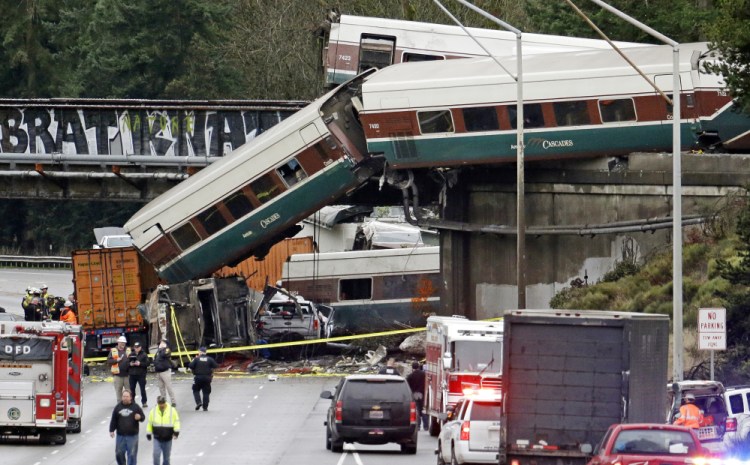SEATTLE – Video from the cab of the Amtrak train that hurtled off the tracks in Washington state, killing three people and injuring dozens, shows that the engineer did not appear to be using a cellphone or any other personal electronic device just before the derailment, federal investigators said Friday.
The video and audio captured from a camera facing inside the cab also revealed that the engineer was heard commenting about the train’s speed just before the train crashed while traveling more than double the posted 30 mph speed limit. But authorities did not provide a transcript of what he said, saying only in a summary that “about six seconds prior to the derailment, the engineer made a comment regarding an over speed condition.”
The video also showed that the engineer did not place the train’s brake handle in the emergency-braking mode as the locomotive was recorded traveling 78 mph, according to the preliminary details of an investigation by the National Transportation Safety Board.
The video recording “ended as the locomotive was tilting and the crew was bracing for impact” south of Seattle on Monday, the safety board said.
The train was carrying 85 passengers and crew members as it made its inaugural run along a fast, new 15-mile bypass route. Officials have said previously that another person was inside the locomotive’s cab being trained by the engineer.
Federal investigators trying to determine the cause of the wreck have gathered data from the locomotive’s event data recorder as well as inward- and outward-facing train cameras. They have said their full investigation could take more than a year.
NTSB board member Bella Dinh-Zarr said earlier this week that the locomotive’s emergency brake went off automatically and was not manually activated by the engineer.
Rail-safety experts have said the engineer should have activated the brake about a minute before the train reached the curve posted for 30 mph (48 kph), and that not doing do strongly suggested that the engineer may have been distracted for an extended period. The engineer, who was among the injured, has not been identified and investigators have said they planned to speak with him soon.
None of the critical train speed-control technology that could have prevented a derailment was active on the section of track where the derailment happened before the train set off on its maiden voyage Monday.
Work to install the GPS-based technology known as positive train control is not expected to be completed until next spring on the newly opened span where the train derailed, according to Sound Transit, the public agency that owns the tracks.
Washington Gov. Jay Inslee, a Democrat, said on Wednesday that Amtrak had committed to making sure the technology will be in place statewide as soon as possible and before the Dec. 31, 2018 deadline.
Passenger service along the rail line where the train derailed will not resume service until the advanced safety systems are in place, Washington transportation officials have said.
Experts have said it is likely the technology would have prevented Monday’s derailment in Washington state.
Rail crash data obtained by The Associated Press found that nearly 300 people have died in train crashes that could have been prevented if railroads across the U.S. implemented that critical speed-control technology – something federal safety investigators have been pushing for close to five decades.
Congress for years has extended the deadlines for railroads to implement positive train control.
On Friday, 15 Democratic U.S. senators, including Sens. Maria Cantwell and Patty Murray in Washington state, sent a letter to Transportation Secretary Elaine Chao saying it’s imperative that railroads put the technology in place before the December 2018 federal deadline.
Investigators have also said they are looking into whether the engineer was distracted by a second person in the cab or by something else. The other person inside the cab was an in-training conductor familiarizing himself with the route.
Send questions/comments to the editors.



Success. Please wait for the page to reload. If the page does not reload within 5 seconds, please refresh the page.
Enter your email and password to access comments.
Hi, to comment on stories you must . This profile is in addition to your subscription and website login.
Already have a commenting profile? .
Invalid username/password.
Please check your email to confirm and complete your registration.
Only subscribers are eligible to post comments. Please subscribe or login first for digital access. Here’s why.
Use the form below to reset your password. When you've submitted your account email, we will send an email with a reset code.